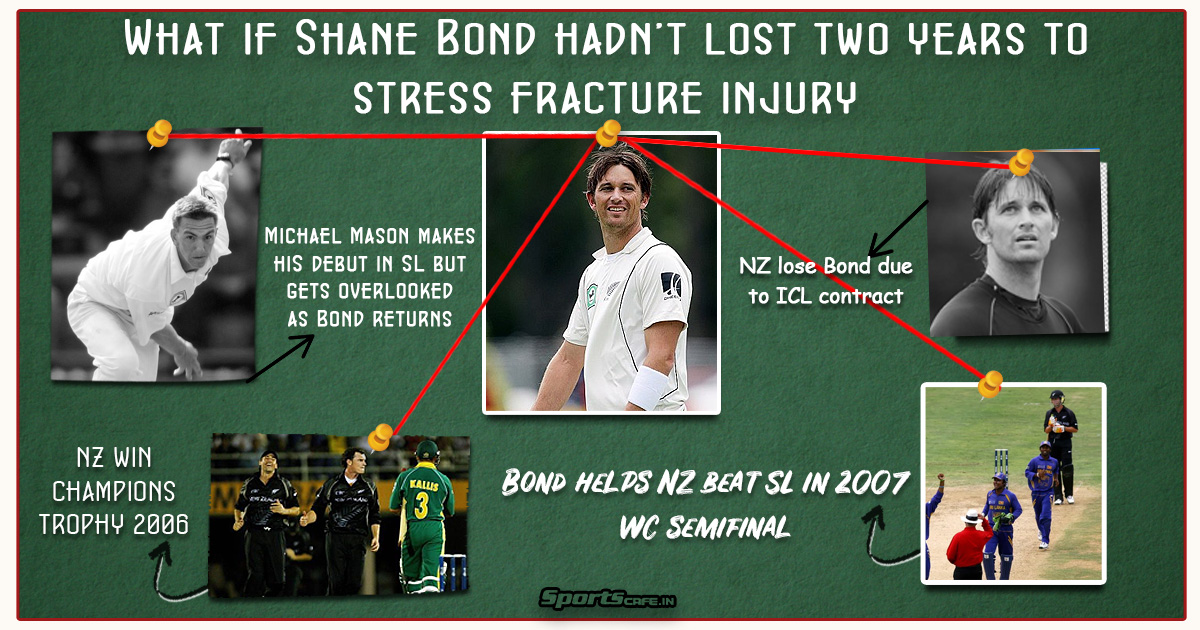What if Shane Bond hadn’t lost two years to stress fracture injury

Shane Bond sustained a career changing stress fracture after World Cup 2003
|SportsCafe
Growing up, many youngsters across the world have tried emulating Shane Bond’s action as he was a spectacle to the cricket fraternity and could’ve been a legend if not for recurrent injuries. But what if Bond’s potentially glorious ODI career wasn’t marred by the stress fracture in 2003?
Shane Bond’s 6/23 against Australia marked a significant moment in New Zealand cricket history as his figures were second best for a player ending up in the losing side. The ace pacer, who made his New Zealand debut in 2002, had 22 wickets at a bowling average of 10.45 against World Champions Australia up until that point. After New Zealand made their exit ahead of the knockouts, Ricky Ponting’s Australia registered a gigantic win over Sourav Ganguly’s Indian team. The two neighbours then met in India for a tri-series in October that year but there was no Bond in the team anymore as Bond had suffered a stress fracture in May 2003 that ruled him out of cricket for four months. However, as history witnessed, Bond only returned to cricket in late 2005. In today’s edition of What if Wednesday, we take a walk in a park from a parallel universe wherein the New Zealand ace pacer made a come back in the same year itself.
Bowed down by the 2003 World Cup exit, New Zealand has made their way to Sri Lanka to play a tri-series with Australia. In the opening game, against the hosts, Bond starts well by bagging 2 wickets while only conceding 7 runs in his first five overs. Following which Bond suffers a major injury which is supposed to rule him out of cricket for four months. New Zealand win the game but lose Bond’s services. This leads to the ODI call up of a sheer hard worker from Central Districts, Michael Mason who successfully translates his domestic proficiency in the international level. After a string of convincing performances, Mason bags three wickets, as many as Kyle Mills, in the final against Pakistan to win the tri-series for New Zealand.
Fleming’s ODI team then go to a hibernation period of five months until ahead of the TVS Cup tri-series in India. Meanwhile, Bond was cleared to return after a potentially career-changing surgery. The importance of Bond lied in his pace and accuracy that was a first for New Zealand cricket since the great Richard Hadlee. Ahead of the India tour, Bond has been incorporated into the squad travelling to India for the TVS cup(tri-series).
Bond’s come back is right in time, even though it marks a halt in Mason’s blooming career, as he helps New Zealand win in India, a significant change as, suddenly, the Kiwis aren’t considered dark horses anymore. In a thrilling contest at the Nehru Stadium in Pune, after being crushed by Australia in Faridabad, Bond bowls the last over and claims the wickets of Andrew Symonds and Brad Williams to record a 1-wicket victory. Following that, Bond and Daryl Tuffey join forces to beat the World Champions in Guwahati by a four-wicket margin with Fleming scoring a hundred.
In the 9th game against India, Bond and Styris wipe out the Indian top order in the first ten overs to restrict them to a total of 205, to help New Zealand claim victory another thrilling chase. In the final of the tri-series, New Zealand meet their neighbours again, at the Eden Gardens in Kolkata, and after twin fifties by Fleming and Vettori, Bond claims a fifer to hand the Aussies a 22-run defeat. Meanwhile, in the Test series in India, Bond shows his class but fails to retain his pace in the longest format. Even though he bags 13 wickets across the two Tests, the series ends in a draw.
In the 2004 series against South Africa at home, with a long-serving all-rounder Chris Harris losing his form, Bond ends up being the match-winner for the Kiwis. New Zealand emerge victorious by a margin of 5-0 in the 7-match series with Bond claiming 22 wickets at home, averaging a brilliant 16. New Zealand step up in the real challenge as they visit Australia for a three-match ODI series. After a four-wicket victory in Melbourne, New Zealand face some challenge in Sydney with a surprise late performance by Brad Hogg but Bond comes in the death to remove Hogg for 31. New Zealand successfully chase down the 241-run target in 49 overs with a fifty each by Chris Cairns and Kyle Mills. After winning the series 2-0, New Zealand miss out on a chance to whitewash the three-time World Cup champions at home as the third match gets abandoned.
New Zealand, who are not considered as underdogs anymore, continue their winning streak as they now defeat Aus 3-2 at home, in 2005, after the away win with Bond and Mills topping the charts. After being the highest wicket-taker in Videocon Cup 2005, Bond helps NZ whitewash old-rivals Sri Lanka at home. After a long time, the Kiwis are able to establish the kind of dominance against their good old enemies. The winning streak continued with the 4-1 win in the home series vs West Indies leading to the Champions Trophy. Meanwhile, Bond’s injury issues aren’t completely out of the picture and he decides to break from Tests to elongate his career in the shorter format. In Wellington pacer Mark Gillespie, who is known for his proficiency in death overs, made eyes turn in the 2005-06 season of Plunket Shield wherein he bagged 43 wickets at 23.16 and replaces Bond in the longest format.
Meanwhile, Bond’s importance in the team leads to NZC announcing him as Fleming’s deputy ahead of the ICC event, to be held in India. Bond, who had already proven himself in India during the TVS Cup, helps his team beat Sri Lanka in the initial stages of the Champions Trophy. Having won all games, New Zealand then meet Australia at a challenging Mohali pitch in the Semi Final, Bond bags three wickets with Mills leading with four scalps to restrict Australia to a total of 198. New Zealand, with Jacob Oram and Nathan Astle’s 108-run partnership, win the game by 3 wickets. As they meet West Indies in the final, Bond bags 5/27 including the wickets of Lara and Gayle to see the Windies to a total of 139. New Zealand chase down the 140-run target with ease and claim the 2006 Champions Trophy title making a case for themselves ahead of next year’s 50-over World Cup.
New Zealand’s biggest challenge in the ICC mega event, in West Indies, were Sri Lanka and Australia, the two teams who have always given a hard time to the Kiwis. But Shane Bond, like in the recent years, makes a big case for New Zealand. Fleming’s team win all Group C games except for the fixture against Sri Lanka but the two teams met again in the semis, only this time the story was different. Kumar Sangakkara had given a hard time to Bond in the previous game and, hence, the ace pacer comes all prepared for the semifinal contest. Before this, New Zealand had played four World Cup semifinals and lost all of them, so the game against Sri Lanka is a crucial one for their cricket history. As James Franklin removes Sangakkara early, Bond uses his tactics an in-form Jayawardene for just 35 runs. From then on Bond wipes out the lower order and bags a splendid five-wicket haul that turns out to be match-winning for New Zealand. And New Zealand FINALLY make it to their first-ever World Cup final after winning their fifth chance at the semifinals.
The Kiwis meet Australia, undefeated in the entire tournament, in the final and the onus is on the second-highest wicket-taker in the series - Shane Bond to make history for his team. The pitch at Barbados is a batting paradise and Australia, who choose to bat first after winning the toss, make full use of it. Veteran keeper Adam Gilchrist steps up for the Aussies and even though Bond get rid of Hayden and Ponting, New Zealand find no answers for Gilchrist. As Australia’s innings is cut short to 38 overs, they manage to put up a total of 270/7 with Bond bagging 5/42. But with the rains, New Zealand’s chances of chasing the gigantic total is evidently difficult. With Australia’s bowling attack led by Glenn McGrath, the Kiwis could only manage a 203 total before getting all out in the 31st over. New Zealand lost the World Cup final but they change the way the world of cricket saw them as a team. They broke the semifinal jinx and Bond’s performance in the World Cup sees him bagging 24 wickets, only second to McGrath’s 26.
World Cup finalists New Zealand enjoy another glorious year with Shane Bond’s services. But a shocker of a news comes to the fore when Bond decides to retire, given the policies of NZC, to leave for the Indian Cricket League, along with Lou Vincent and others, and never comes back. The Kiwis now have to start afresh as they give a call back to Michael Mason who was hardly seen in three years.
